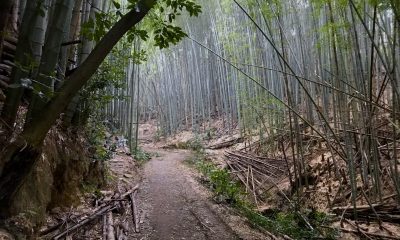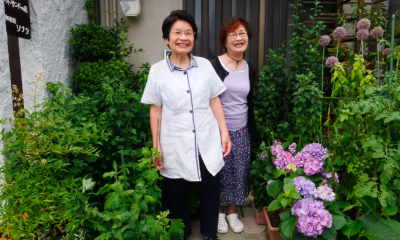Feature
Bend it Like Butoh
William Bradbury steps outside his comfort zone to discover avant-garde dance in Kyoto.
I am curled up on the floor as instructed, feeling my partner’s hands against my back and allowing my body to be rolled along the ground. She reminds me to try to see my body as an object, yet the more I try to think about relaxing it, the more tense I become. My shoulder hits the ground with a thud and I curse my form for its clunky movement.
We switch roles and I put my hands on the back of my partner. Unlike my rigid body, which clunks along the ground like a jagged rock, hers moves fluidly and I am surprised at the ease with which it responds to the direction I guide it with my hands.
I am in Kyoto at a Butoh workshop run by Ima Tenko, a Japanese dancer who holds Butoh classes twice a week near Kuujo Station. Ima has been performing Butoh since 1979, and since 2007 has been running her workshop.

Photo: Hiroshi Mimura
Kyoto university student Caitlin Coker, in her second year of her doctorate program researching Butoh, says “Butoh is a rebellion against modern dance.”
“With Butoh, they studied modern dance and jazz dance and broke away from it and created their own movement. In Butoh there’s breaking the rules of modern dance and breaking the rules of what you can do in dance.
“In modern dance, you want to show the body as a generally accepted form of beauty, think of ballerinas … but in Butoh there’s a kind of grotesqueness, yet Butoh shows the grotesqueness as something beautiful. It takes an anti-social person, but shows that as humanity. There’s also generally a chaotic, wild feeling,” she explained.
The room we’re in is an old building with a large, cracked mirror in the far right-hand corner. It is older and more run down than what might first come to mind when thinking ‘dance studio in Japan,’ but that gives it a rustic charm.
“Imagine your body is like a liquid form,” Ima guides us, “Imagine you’re like a bucket of water that’s spilt,” she says and demonstrates by hurling her torso towards the ground and flailing her arms. I try to imitate her free movements but there’s a self-consciousness to my effort. This is not something that comes easily to a first-time dancer.
“It is important not to think when performing the exercises,” says Ima. Easier said than done. Seeing Ima’s ease of movement and the way she could relax her body made me realize how detached I am from my own.
The next activity involves walking from one side of the room to the other, using consciously slow steps. Again we work in pairs, and Ima reminds us that it’s important not to rush these movements.
My partner holds onto my hips and pulls me back as I move slowly towards the other side of the room. I pick up one foot very carefully, hold it in the air for the moment, and then stretch my leg out towards the ground before doing the same with the opposite foot.
After walking back and forth across the room several times we stop the activity. I look at the clock and realize over two hours have passed since the start of the workshop. In the past two hours I had gained an understanding of Ima’s motivation for starting the workshop. She says she feels as though Butoh is more important now than ever before, because with smartphones, computers, and other technology, people have become so disconnected from their bodies in modern society.
Although it is sad that the Butoh scene is not thriving in the way it was in the 70s and 80s, the passion that I saw in the performers who continue the dance form is an inspiration to continue doing the things you find value in, regardless of how popular those things are. We live in a time where the amount of ‘likes’ we get on social media is our validation for the things we do or create, but in researching Butoh I was reminded there are other more important things than having a high view count.
Ima’s workshop is a great place to get a first-hand experience of Butoh, yet Kyoto has places to experience Butoh as a spectator as well. Urban Guild – a cafe on Kawaramachi street – has occasional Butoh performances as well as a range of other avant-garde events.
There is also a place named Nishijin Factory Garden on Kamidachiuridori which has a traditional look and also holds showcases for creative talent including Butoh performances. The events take place sporadically but there is usually an event somewhere in Kyoto once a month.
[box]
More details
Ima Tenko’s workshop takes place twice a week on Thursdays and Saturdays.
The class fee is ¥1,000 to try Butoh for two hours.
[/box]






















